Insulation of the ceiling in a private wooden house inside and out: choosing the best material and the nuances of installation
Although the wooden house is warm in itself, the upper enclosing structure in it is a weak link, except that the attic is heated, but this happens extremely rarely. Therefore, it is important to timely perform the insulation of the ceiling in a private house, which will help reduce heat costs and save on heating homes.
There are several options for thermal insulation of the ceiling. To determine the optimal insulation and the method of its installation, it is necessary to evaluate the pros and cons of each method, agree? We suggest sorting out this issue in order.
In the article, we examined in detail the technologies for conducting thermal insulation works using different types of insulation, indicated the characteristics and operational characteristics of the materials. In addition, they told when it is better to use external, and when internal insulation of the ceiling, and gave tips on choosing a thermal insulation layer.
The content of the article:
Methods of insulation of a wooden ceiling
At the place of installation of the insulation, all existing thermal insulation technologies are divided into two categories: internal and external.
Each of them has its pros and cons. The first method is more economical, but you will have to sacrifice the useful volume of rooms. And in the case of external insulation, they usually strengthen the floor, and then arrange the flooring of the attic.
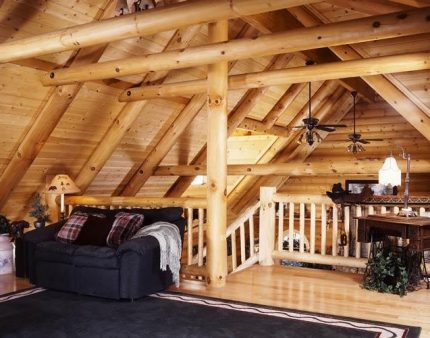
Insulation on the outside is a risk of damage from any mechanical influences, so additional protection is necessary. In this case, one cannot do without steam and waterproofing, which will also entail an increase in the cost of the insulation layer.
The best materials for outdoor insulation
The industry produces a wide range of heaters. Each of them has its own properties, positive and not quite qualities. First of all, environmental friendliness is important - they should not be harmful to health.
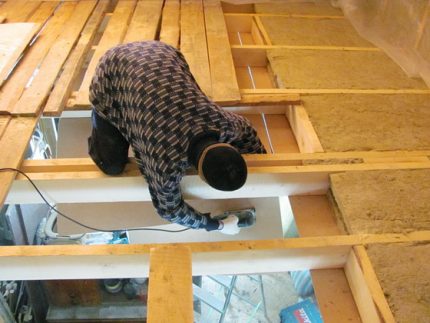
It is important that the insulating layer does not create an unnecessary load on the ceiling structure and copes well with the task of retaining heat. Also, it should not accumulate condensation on itself and be resistant to fire.
The material used for insulation is divided into 4 categories:
- bulk - this group includes ecowool, expanded clay, sawdust;
- plate - it is expanded polystyrene, mineral wool dense sheets, cork plates;
- rolled - all varieties of mineral wool;
- sprayed or bulk - here we are talking about penoizol.
Let us consider in detail the characteristics of the main materials used as insulation.
Sawdust as a heater
Despite the great number of new materials, the relevance of sawdust remains the same. They are easily accessible, cheap, and in quality they are not inferior to expensive heat insulators.
We need sawdust that is stored for no more than a year, dry, odorless and moldy, medium in size. The volume of material is determined based on the area to be insulated.
Alternatively, sawdust is soaked in a solution of copper sulfate. After drying will be required, and then a mixture of wood material and cement is prepared.
In a proportion of 1:10, a cement mortar is made - for every one and a half buckets of liquid, 10 buckets of sawdust are added. The output is a bright gray and wet mixture. It is subsequently distributed along the plane of the ceiling. Recommended insulation layer height - 20 cm.
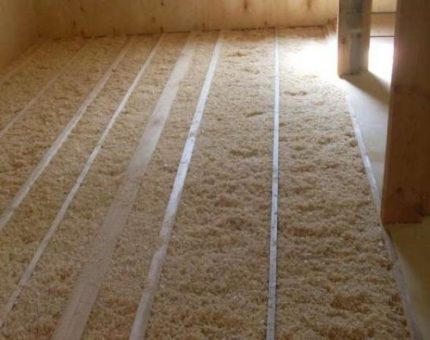
To improve the adhesion of thermal insulation to the surface of the ceiling, the layer can be slightly trampled, it will be compacted and it will be better to retain heat. When the mortar of chips and cement dries, you can walk on it.
Sometimes, before mixing sawdust with cement mortar, lime or gypsum is added. This makes the insulation immune to rodent attacks, and increases its fire safety.
Ceiling insulation with expanded clay
Another old, but not completely forgotten way of warming is a layer of expanded clay on the ceiling. The full environmental friendliness of the material attracts, since expanded clay is just high-strength balls obtained from fired clay.
The material is durable, well resists deformation, absorbs moisture, which subsequently evaporates. The attic, insulated in this way, is always dry, therefore, wooden structures last longer.
The thermal insulation characteristics of expanded clay are still lower than that of the latest generation of insulation materials.
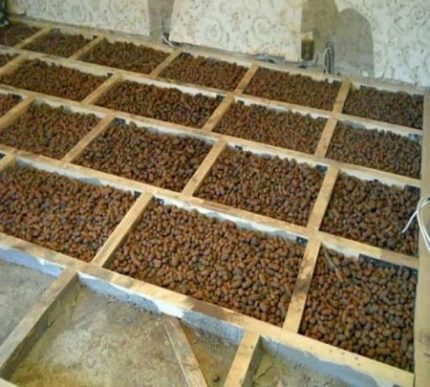
Small and medium fractions are best suited. Before laying it, the surface is cleaned of everything outside, covered with a glassine or a special membrane.
Expanded clay is poured over a hydro-vapor barrier layer. Further, the surface is preferably covered with a board or plywood. OSB boards can also be used. Also suitable is a cement screed.
Expanded polystyrene plates for the ceiling
The heat-holding properties of expanded polystyrene are much higher than that of bulk materials. Since the plates are lightweight, they minimize the load on the ceiling structure.
It’s easy to work with this material. It is easily cut, so adjusting it to the openings is not difficult. On sale there are sheets of different thicknesses.
Since this insulation does not pass air well, it must be separated from the wooden structures with a vapor barrier material. Otherwise, condensation will occur.
Slots at the joints also relate to the disadvantages of this method of insulation. Heat is lost through them, so you can not do without the use of mounting foam.
Lay the material as follows:
- The base is cleaned and a vapor barrier is placed on it.
- Give the sheets of expanded polystyrene the desired geometry and dimensions.
- Lay out the material, tightly pressing it to the base.
- Fill the joints with foam.
- Remove excess hardened foam.
If the attic is going to be used, the topcoat is laid on the slabs in the form of a reinforced concrete screed of at least 50 mm thick.
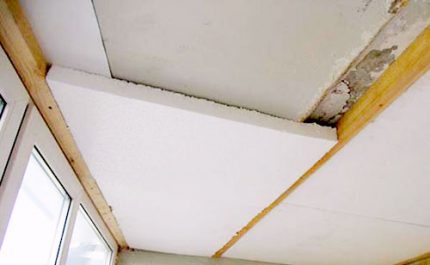
Although polystyrene foam has an unnatural origin, it does not emit harmful substances during operation. This material does not decay, is not subject to corrosion, does not contribute to the appearance of fungus, mold.
The average operational life of the material is 20 years. A negative property is fragility, instability to chemical reagents.
Rockwool
Mineral wool in rolls has the lowest density - 1-11 kg / m3. This is explained by the fragility of the fibers. If you make the material dense, it will not curl up. Mineral wool refers to non-combustible materials.
Since it is easy and convenient to lay, this material is most often used. With its help, you can insulate the ceiling in a wooden house both outside and inside. It will not cost very much.
The fibers in the glass wool are arranged randomly, which provides both high thermal protection and sound insulation. There are separate lines of materials that absorb sound vibrations.
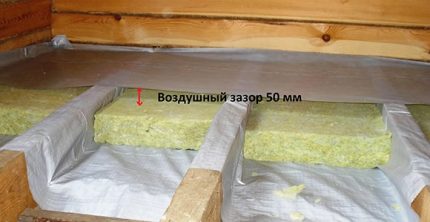
As a minus, low moisture resistance can be noted. This material must not be tamped, since the air contained between the fibers will leave and the thermal conductivity will be significantly reduced.
Laying technology is also simple:
- The surface of the floor is cleaned, be sure to remove or hammer the entire length, nails sticking out of wooden structures.
- A vapor barrier film is laid.
- Lay the mineral wool, trying not to leave gaps.
- The mineral wool is covered with a polymer film or foil material.
If you plan to periodically walk through the attic, you need to arrange a wooden flooring, fixing it in such a way that it does not exert pressure on the insulation layer.
In some types of mineral wool, phenol is present. However, if you do not go beyond the available temperatures, this dangerous substance will not be released.
Features of insulation with penoizol
Penoizol is a foam in liquid form. It refers to those materials that cannot be used without special equipment. It is poured or sprayed, proceeding from the type of installation.
In addition to equipment, you need a protective suit. It is difficult to do the job without professional skills.
The main advantage is that the material fills not only all the cracks, but also microcracks. In addition, it is safe, non-combustible, they are not interested in rodents. The structure of the material contains many air bubbles, which guarantees excellent insulation.
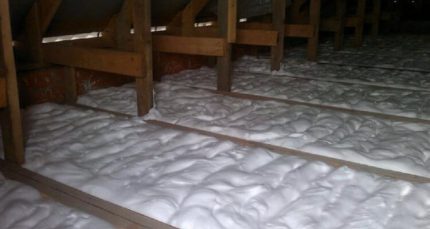
Schematically, the technology looks like this:
- vapor barrier is laid on the surface;
- fill the gaps between the beams with penoizol with a layer of about 25 cm;
- lay a layer of roofing material or other similar material;
- lay a plank finish.
Negative quality - fragility, mechanical effects to the material are contraindicated. The high cost also can not be attributed to the advantages of penoizol.
Indoor ceiling insulation
Insulating the ceiling of a wooden house from the outside is easier, the work on internal insulation is somewhat more complex.
This method is attractive in that less materials are consumed, work can be done in conjunction with decoration at any time. This reduces financial costs.
Although the method of internal insulation of the ceiling structure is effective, it is not worth implementing it if the house has recently been renovated.
Option # 1 - insulation from the inside with mineral wool
For insulation, rolled mineral wool will be used.
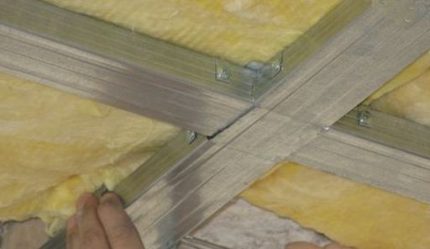
The process consists of 11 consecutive steps:
- Marks are placed on the ceiling in the corners. The best solution is to use a laser level for this.
- Transfer marks on the walls to the desired height, taking into account the height of the profile and the thickness of the roll.
- Mark the line with a cord.
- A profile is attached along the line with self-tapping screws.
- They apply a CD profile to the ceiling, measure the desired length, and perform its installation at a distance of 40 cm from each other.
- For each profile at a distance of 70-90 cm, U-shaped suspensions are fixed.
- Pull the fishing line from the edge of every third profile.
- The profile is screwed to the suspension by fishing line. The remaining profiles are fixed using the level or rule, based on the profile fixed before this.
- Mineral wool is laid between the profile. Fix the panels with the help of suspensions.
- Screw the sheets of drywall in a checkerboard pattern with screws. A gap of 5 mm is left around the perimeter of the ceiling.
- Joints in places that remain free are reinforced with a profile, and then they are covered with pieces of drywall.
Metal or wooden frame - additional costs. But this method of fastening the insulation opens up great opportunities for decorative decoration of the ceiling.
Option # 2 - insulation with foam
To get a perfectly even surface layer that retains heat well, foam is used for insulation.
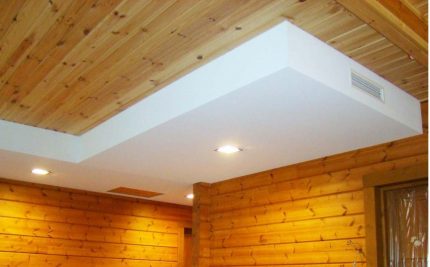
Method 1. To insulate the ceiling using the frame method, it is necessary to prepare: self-tapping screws for wood, washers with a large outer diameter and polystyrene with a thickness of about 300 mm.
Sequencing:
- The ceiling is covered over the entire plane with a deep penetration primer and allowed to dry.
- Make markup.
- Foam is fixed using self-tapping screws.
- The insulation is putty with the imposition of a reinforced mesh with a 2.5 mm cell.
- Put a layer of finishing putty, then paint the surface.
Method 2. Polyfoam is not screwed to the ceiling, but glued. For this purpose, use a polymer adhesive mixture or ordinary starting gypsum plaster. The main thing is not to immediately knead a large amount, since the latter has a limited time of use.
The mixture is applied on one side of the foam sheet, placing it in slides in the corners, between them and in the center.
The sheet is pressed against the ceiling surface, its spatial position is adjusted using the building level. Having finished laying the first row, begin the installation of the second. At the same time, they try to avoid continuous seams.
If a full-sized sheet is laid at the beginning of the first row, then the second row should start half the plate. Further, the entire structure is plastered twice, then coated with a finish.
Instead of polystyrene, you can use extruded polystyrene foam - the material is characterized by high heat efficiency, good strength and resistance to negative influences.
Option # 3 - installation of penofol on the ceiling
Penofol is a great option for insulating the ceiling from the inside of a wooden house. It consists of polyethylene foam and polished foil.
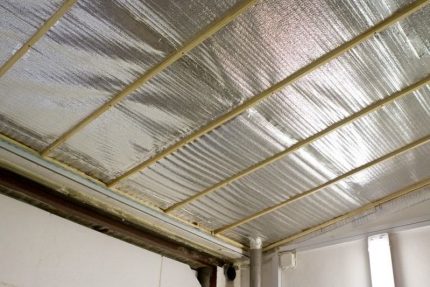
The installation sequence is as follows:
- A strong crate is arranged on a wooden ceiling.
- Fasten penofol with the foil side inside the room. You can fix the material with nails.
- Gaps for ventilation are left on both sides of the insulation layer.
- They arrange another crate.
- Drywall is attached. Instead, you can perform a stretch ceiling.
The thermal resistance of this material with a thickness of 0.3 cm is identical to the corresponding parameter of an extruded polyurethane foam having a thickness of 3 cm. Penofol is used as an independent heater and in combination with other heaters.
The two substances included in the structure of penofol are non-combustible, therefore, they are used indoors without any restrictions. It is a good sound absorber, does not allow moisture to pass through, so there is no need for additional moisture protection.
The disadvantages are the lack of rigidity, as well as the moment that it does not adhere well. It is necessary to fix it with nails or brackets, which reduces its operational properties. To compensate for this shortcoming, manufacturers began to produce self-adhesive penofol.
If you violate the installation technology, spores of fungus or mold may develop in the insulation.
Option # 4 - a combination of penofol and mineral wool
In order to perform such a double insulation of the ceiling from the inside, a structure is assembled, like under drywall. Mineral wool is laid between the profiles. Penofol is fixed on top of the frame, by means of screws, it is fixed to the supporting profile.
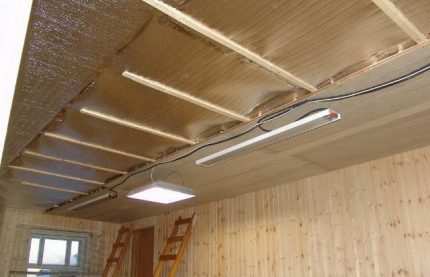
Stripes are laid without overlapping, but end-to-end. The joints are glued with foil tape. At the next stage, plasterboard lining is made, then final finishing is performed.
Which insulation is better?
The quality of insulation of a wooden ceiling structure depends on which insulation is selected and its installation is so well done.
The effectiveness of thermal insulation is best seen in cold weather. Everything is simple here - if it has become warmer, then the insulation works.
Doubts can be dispelled with a little snow. He is left in the attic if after a while he melts - everything is in order with protection. When the snow has not yet fallen, you can put ice cream or ice from the freezer in the attic.
Based on the price of the material, mineral wool is the best option for both external and internal insulation. As for the price tag, the more economical options are sawdust and expanded clay, which are suitable only for external installation.
To facilitate the selection, you can use the table.
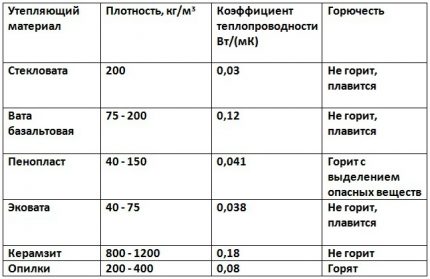
Styrofoam is a relatively inexpensive material, but it is not entirely reliable from the point of view of environmental friendliness.
It is worth worrying in advance about the insulation of the floor in the house to prevent heat leakage through the lower floor. Practical recommendations for choosing the best thermal insulation material are given in this article.
In addition to using traditional insulation technology, you can use a more progressive and practical solution - equip a warm floor. Such a system can completely replace standard heating or become its effective complement.
Conclusions and useful video on the topic
Interesting ideas for ceiling insulation:
The nuances of warming the ceiling from a bar:
If there is no residential or insulated attic in a wooden house, you can not do without insulation of the ceiling. The ideal case is the insulation of the ceiling during the construction process.
Installation of the insulation layer in the already built house is somewhat more difficult to carry out, but still possible. It is important to follow the technology and take into account the features of the selected heat insulator.
Do you have any personal experience with ceiling insulation in a wooden house? Do you want to share your accumulated knowledge, talk about the nuances of the work or ask questions on the topic? Please leave comments and participate in discussions - the feedback form is located below.

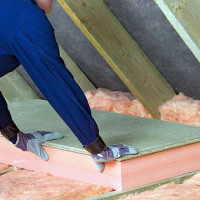 Ceiling insulation in a house with a cold roof: types of effective heaters + installation instructions
Ceiling insulation in a house with a cold roof: types of effective heaters + installation instructions 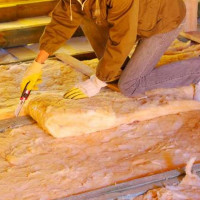 Floor insulation in a wooden house: work procedure + popular heaters
Floor insulation in a wooden house: work procedure + popular heaters 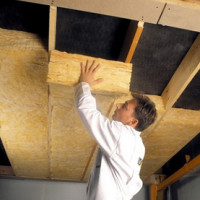 Insulation for the ceiling in a private house: types of materials used + how to choose the right
Insulation for the ceiling in a private house: types of materials used + how to choose the right 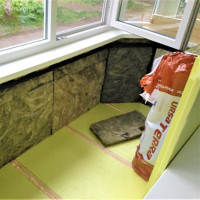 Do-it-yourself warming the balcony: popular options and technologies for warming the balcony from the inside
Do-it-yourself warming the balcony: popular options and technologies for warming the balcony from the inside 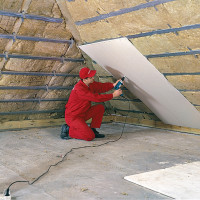 Do-it-yourself attic insulation from the inside: step-by-step instruction on insulation + tips for choosing materials
Do-it-yourself attic insulation from the inside: step-by-step instruction on insulation + tips for choosing materials 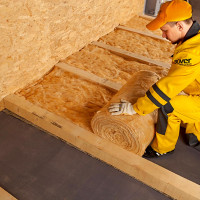 Insulation for the floor in a wooden house: materials for thermal insulation + advice on choosing insulation
Insulation for the floor in a wooden house: materials for thermal insulation + advice on choosing insulation  How much does it cost to connect gas to a private house: the price of organizing gas supply
How much does it cost to connect gas to a private house: the price of organizing gas supply  The best washing machines with dryer: model rating and customer tips
The best washing machines with dryer: model rating and customer tips  What is the color temperature of light and the nuances of choosing the temperature of the lamps to suit your needs
What is the color temperature of light and the nuances of choosing the temperature of the lamps to suit your needs  Replacement of a geyser in an apartment: replacement paperwork + basic norms and requirements
Replacement of a geyser in an apartment: replacement paperwork + basic norms and requirements
Is there something else that makes warming with sawdust? I understand it is cheap (maybe even for free if you have friends somewhere on the sawmill or in the furniture workshop), but still there are so many new materials.
Why not? The method is proven, has its advantages. Although there are many disadvantages, in comparison with modern materials, in sawdust. High fire hazard, the fact that they accumulate and absorb moisture. In part, these disadvantages are mitigated if a mixture of sawdust with clay or gypsum is made and treated with an antiseptic.